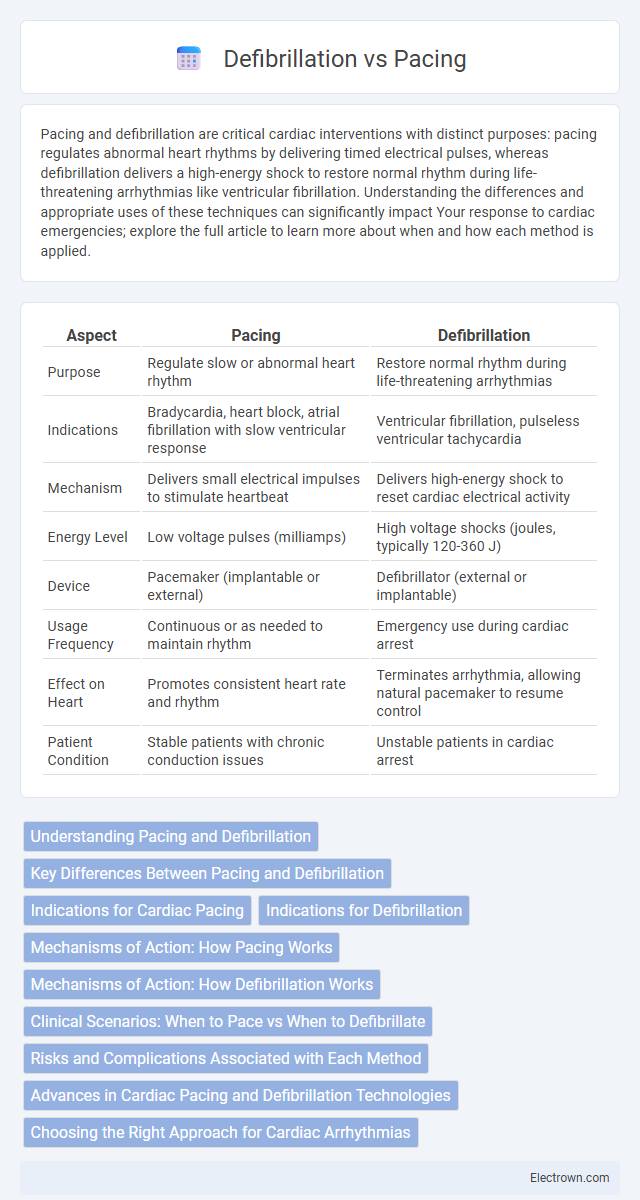Pacing and defibrillation are critical cardiac interventions with distinct purposes: pacing regulates abnormal heart rhythms by delivering timed electrical pulses, whereas defibrillation delivers a high-energy shock to restore normal rhythm during life-threatening arrhythmias like ventricular fibrillation. Understanding the differences and appropriate uses of these techniques can significantly impact Your response to cardiac emergencies; explore the full article to learn more about when and how each method is applied.
Table of Comparison
| Aspect | Pacing | Defibrillation |
|---|---|---|
| Purpose | Regulate slow or abnormal heart rhythm | Restore normal rhythm during life-threatening arrhythmias |
| Indications | Bradycardia, heart block, atrial fibrillation with slow ventricular response | Ventricular fibrillation, pulseless ventricular tachycardia |
| Mechanism | Delivers small electrical impulses to stimulate heartbeat | Delivers high-energy shock to reset cardiac electrical activity |
| Energy Level | Low voltage pulses (milliamps) | High voltage shocks (joules, typically 120-360 J) |
| Device | Pacemaker (implantable or external) | Defibrillator (external or implantable) |
| Usage Frequency | Continuous or as needed to maintain rhythm | Emergency use during cardiac arrest |
| Effect on Heart | Promotes consistent heart rate and rhythm | Terminates arrhythmia, allowing natural pacemaker to resume control |
| Patient Condition | Stable patients with chronic conduction issues | Unstable patients in cardiac arrest |
Understanding Pacing and Defibrillation
Pacing involves delivering controlled electrical impulses to regulate or stimulate the heart's rhythm, commonly used in bradycardia or heart block cases to maintain adequate heart rate. Defibrillation delivers a high-energy shock to terminate life-threatening arrhythmias like ventricular fibrillation or pulseless ventricular tachycardia, restoring normal cardiac rhythm rapidly. Understanding these distinct techniques is critical for effective emergency and chronic cardiac care management.
Key Differences Between Pacing and Defibrillation
Pacing involves delivering controlled electrical impulses to regulate slow or irregular heartbeats, while defibrillation provides a high-energy shock to terminate life-threatening arrhythmias such as ventricular fibrillation or pulseless ventricular tachycardia. Pacing aims to maintain consistent heart rhythm and cardiac output, whereas defibrillation restores normal rhythm by depolarizing the entire myocardium simultaneously. The devices differ significantly, with pacemakers providing continuous rhythmic stimulation and defibrillators delivering intermittent high-voltage shocks during arrhythmic emergencies.
Indications for Cardiac Pacing
Cardiac pacing is indicated primarily for bradyarrhythmias such as symptomatic sinus node dysfunction, atrioventricular block, and certain cases of heart failure with electrical dyssynchrony. It is also used to prevent or treat pauses and maintain adequate heart rate during episodes of asystole or severe bradycardia. Unlike defibrillation, which treats life-threatening tachyarrhythmias like ventricular fibrillation or pulseless ventricular tachycardia, pacing supports chronic management of slow heart rhythms.
Indications for Defibrillation
Defibrillation is indicated for life-threatening arrhythmias such as ventricular fibrillation (VF) and pulseless ventricular tachycardia (VT), where rapid restoration of a normal heart rhythm is critical to prevent sudden cardiac death. Unlike pacing, which is used to treat bradyarrhythmias and heart block, defibrillation delivers a high-energy shock to depolarize the myocardium and allow the sinoatrial node to regain control. Prompt defibrillation within minutes of cardiac arrest significantly improves survival rates in patients experiencing these shockable rhythms.
Mechanisms of Action: How Pacing Works
Pacing works by delivering controlled electrical impulses to the heart muscles, prompting them to contract and maintain a regular rhythm. This mechanism helps correct bradyarrhythmias where the heart beats too slowly, ensuring adequate blood flow throughout your body. Unlike defibrillation, pacing does not reset the heart's rhythm but instead provides a steady stimulus to sustain it.
Mechanisms of Action: How Defibrillation Works
Defibrillation works by delivering a controlled electric shock to the heart, depolarizing the cardiac cells simultaneously to stop erratic electrical activity and restore a normal sinus rhythm. This electrical impulse interrupts the reentrant circuits causing ventricular fibrillation or pulseless ventricular tachycardia, allowing the sinoatrial node to regain control of the heartbeat. Unlike pacing, which stimulates heart contractions through timed electrical pulses, defibrillation produces a higher energy shock aimed at resetting the entire myocardial electrical environment instantaneously.
Clinical Scenarios: When to Pace vs When to Defibrillate
Pacing is indicated in clinical scenarios involving bradyarrhythmias such as symptomatic sinus node dysfunction or heart block where maintaining adequate heart rate is critical. Defibrillation is essential during life-threatening ventricular arrhythmias like ventricular fibrillation or pulseless ventricular tachycardia to restore organized cardiac rhythm rapidly. In emergency settings, prompt differentiation based on ECG findings guides whether electrical stimulation via pacing or high-energy shocks through defibrillation is required for optimal patient outcomes.
Risks and Complications Associated with Each Method
Pacing carries risks such as lead displacement, infection at the implantation site, and pacing-induced arrhythmias, which may require immediate medical intervention. Defibrillation poses complications including skin burns, myocardial damage, and the potential for inducing ventricular fibrillation or other arrhythmias due to high-energy shocks. Both methods require careful monitoring to minimize adverse effects and ensure effective cardiac rhythm management.
Advances in Cardiac Pacing and Defibrillation Technologies
Advances in cardiac pacing and defibrillation technologies have significantly improved patient outcomes by enhancing device miniaturization, battery longevity, and real-time monitoring capabilities. Modern pacemakers now incorporate adaptive algorithms that optimize heart rhythm management while implantable cardioverter-defibrillators (ICDs) utilize sophisticated arrhythmia detection to deliver precise therapeutic shocks only when necessary. Integration with wireless communication platforms facilitates remote patient management, reducing hospital visits and enabling proactive intervention for cardiac events.
Choosing the Right Approach for Cardiac Arrhythmias
Choosing the right approach for cardiac arrhythmias depends on the specific type and severity of the condition, with pacing primarily used to correct bradyarrhythmias by maintaining a regular heart rate, while defibrillation is essential for terminating life-threatening tachyarrhythmias such as ventricular fibrillation. Your healthcare provider evaluates factors like arrhythmia type, patient stability, and underlying heart disease to decide between temporary pacing, permanent pacemakers, or urgent defibrillation. Timely intervention with the appropriate technique can significantly improve cardiac function and patient survival outcomes.
Pacing vs Defibrillation Infographic

 electrown.com
electrown.com